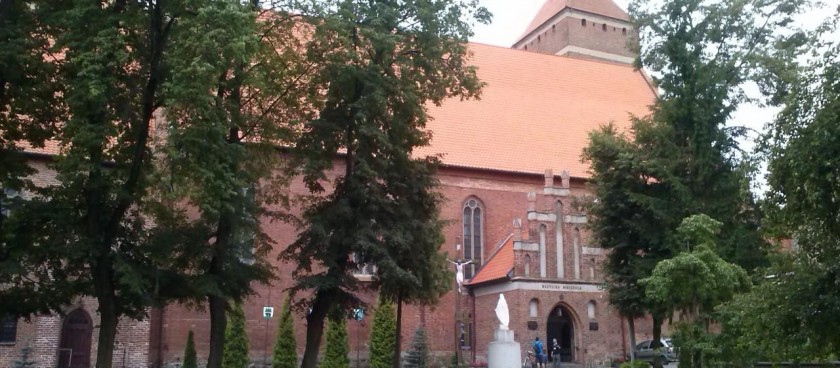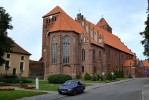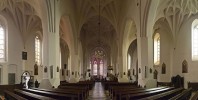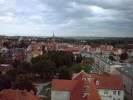- #PL09
- ul. Zamkowa 5, Kętrzyn, Poland
- +48897524535
- bazylika-ketrzyn@olsztyn.opoka.org.pl
- http://bazylika.ketrzyn.pl/
- 54.0747350, 21.3731740 Copy to clipboard Copy
-
#Churches
Catholic parish church of Saint. George was erected in the years 1359-1407 and was included in the city fortification system. The thick walls of the building were so wide that they did not need anything. Until today, the church, with its two heavy towers, resembles a more powerful castle than a gothic temple. The original building was single-nave. At the turn of the fourteenth and fifteenth centuries, a thorough reconstruction took place and so the church became a three-nave basilica of the ceiling. The western summit and the south-western tower were raised, and on the south side the chapel of St. Jacob. In 1500, a presbytery with a three-story sacristy with a star-shaped ceiling was raised. It is worth noting that the presbytery is inclined obliquely to the axis of the nave, which is an architectural peculiarity not only in Poland, but also in Europe. Visitors to the temple standing in the middle of the church see only two stained glass windows in the presbytery - funds and right. To see the left stained glass, you have to clearly move to the right.
Another attraction of the temple are two tiny targets in the basement of the west tower, to which they lead down, narrow steep stairs. They are probably medieval prison cells that can only accommodate one prisoner. A legend about a condemned man is attached to this place, which the Teutonic Knights imprisoned. In a dark cell, the prisoner appeared to Our Lady and instructed to carve her likeness. When in the morning the soldiers looked into the carcer and saw the sculptured figure, they were very surprised and considered it a miracle. They released a prisoner who, on his way to Reszel, suspended a statue on July. And this is how the Marian sanctuary in Święta Lipka was created. The final appearance of the church of St. George was awarded in 1515 and master Matz from Gdańsk rebuilt. He made crystal vaults: eight-armed stars inscribed in two four-armed stars, which replaced the existing wooden ceilings and constitute a great artistic value. In 1525-1946 the church was occupied by Protestants. The monumental temple suffered greatly during fires in 1500 and 1592, and from lightning strikes in 1638 and 1700, as later during World War II. In 1945, as a result of blowing up Hitler's bunker in nearby Gierłoż, all windows flew out, most of the roof tiles fell down and the vault cracked.
Before handing the church over to the Catholics on May 31, 1946, many valuable monuments were lost. Since then, construction and conservation works have been continuing to the present day. In 1962, the construction of the Chapel of Our Lady of Ostrobramska was begun, which was dedicated on November 13, 1966. 16 new stained glass windows were put in according to the design of Maria Palisz-Bardońska from Poznań in 1971-73, in those years the organs were repaired. The bell tower has been renovated. A significant date for the church of St. George is June 1, 1954 - the creation of the parish.
The interior of the church
The Collegiate Basilica impresses and impresses not only with its size, but also with its beauty. The former main altar in the neo-gothic style is currently located in the northern aisle. In the central part of the altar is placed a picture of the Crucified, painted by the then director of the Academy of Arts in Królewiec, Rosenfelder. In the place of the former neo-gothic main altar, a new tabernacle and a new granite conciliar altar were located. His consecration was made by Archbishop Piszcz on April 25, 1999. In the presbytery, stained glass made according to the design of M. Pawlisz-Bardońska was placed. Above the sacristy there is a gallery for a museum room. There is a rich photographic and historical documentation showing the pre-war church furnishings. After entering the collegiate on the right, there is a tombstone of Krzysztof Schenk von Tautenburg d. 1597 with the image of the whole figure of the deceased. Further on at the separate altar, the due honor is received by Our Lady of Perpetual Help. Pieta is next to the altar. On the left side of the north entrance there are two pictures on the wall. The first is Saint Martin. This is an outstanding example of Western European court painting from the second half. XVII w. Drugi - Apostoł św. Tomasz valuable painting from the 60-th 17th c. As a gift for the church from the collections of the Windykaj family on July 18, 1828. In the right aisle was the chapel of Our Lady of Ostra Brama. The construction began in 1962, and was consecrated on November 13, 1966. A copy of the Vilnius painting was made by Stanisław Rudziński from Kętrzyn.
The most valuable and preserved monument from the old rich equipment is a pulpit that was created in 1594. Made in the style of Dutch mannerism, founded by Kaspra Rinwang and Michał von Hohendorf, whose coats of arms are on the pulpit's body. This monument represents high artistic values of woodcarving and painting, currently after renovation. The organ maker from 1721 was Jan Josue Mosengel, also a builder in Saint. Lipka. Their thorough reconstruction was carried out by M. Terletzki in 1882. The company Czesława Kraszewski from Warsaw carried out a general overhaul of organs in 1971-73. Today it is an instrument of three manuals and one football keyboard. It counts 45 votes, including bells and bells. Currently, the organs in Kętrzyn are included in the group of concert instruments. Worth seeing are the two goals of the punishment from the beginning of Fifteenth century, the consecrated cross painted on plaster in 1517, discovered in 1994 and subjected to conservation in 1996, as well as the painting "Photo from the cross" from the old altar from the 16th century. An interesting fragment of the portal of the northern entrance to the first single-nave church from the 14th century.
On the bell tower there are three steel bells from 1923 weighing 3400 kg, 2000 kg and 1000 kg. Thanks to the efforts of priest Prelate Mieczysław Żuchnik on the pillars of the church there are plaques - rosary stations as a votive offering on the occasion of the 25th anniversary of the pontificate of the Holy Father John Paul II in the Rosary Year 2003. They were founded by the society of Kętrzyn and the dedication was made by priest. Archbishop Edmund Piszcz. Basilica of St. Jerzy testifies to the scale of the richness of the historical and cultural temple. One should also remember that a temple is not only a historical object, but above all a place of worship and transformation of the inner man.



